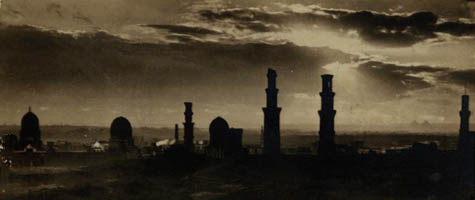 [Image: Cairo, photographed by Nick Leonard].
[Image: Cairo, photographed by Nick Leonard]."We’re not just talking typical city noise," the article says, "but what scientists here say is more like living inside a factory."
- This is not like London or New York, or even Tehran, another car-clogged Middle Eastern capital. It is literally like living day in and day out with a lawn mower running next to your head, according to scientists with the National Research Center. They spent five years studying noise levels across the city and concluded in a report issued this year that the average noise from 7 a.m. to 10 p.m. is 85 decibels, a bit louder than a freight train 15 feet away...
The article goes on to talk to people who are shouting – without realizing that they're shouting – even while they rail against the all-pervasive noise; with people who are screaming – without realizing that they're screaming – even while denying that the city has become quite loud; and with one man who, oblivious to the cacophonous sounds around him, turns on his radio – and cranks it all the way up in order to hear it.
The overall effect, then, is that the city now sounds more like a stationary airplane engine, an endless and deafening roar on the deltaic northern fringe of the Sahara Desert.
 [Image: Cairo, as featured on an old postcard, originally uploaded by Flickr user ptrosss].
[Image: Cairo, as featured on an old postcard, originally uploaded by Flickr user ptrosss].But this also reminds me of two things.
Provided I can ever get my act together on this, I've got a long and totally fascinating interview with Jace Clayton, aka DJ /rupture, coming up here on the blog, in which we discuss the sonic qualities of cities, focusing on New York and arriving there via Marrakech, Barcelona, and even Rennes, France. (Jace, sorry it's taken so long!)
Second, I've mentioned this before, but I've got a short article coming up in Dwell about the future sounds of carless eco-cities – how entire urban soundscapes will change once cars go hybrid/electric, and the internal combustion engine slowly disappears. That's in the June issue. I really can't wait to talk more about that, actually – but I'll have to refrain, again, for now.
But how much of this urban noise, like that described in Cairo, is purely circumstantial? You go to a bar or a party, for instance, and it's often the case that everyone's speaking loudly because everyone else is speaking loudly – so someone turns the music up to make sure everyone can hear it, which makes everyone speak louder, and the music goes up, and so on. Now distribute and multiply this process across a whole city – and you get a kind of metropolitan echo chamber, its streets amplifiers, its buildings resonating gourds and reverberatories.
I'm tempted to organize something called World Noise Day. Make your city as loud as possible. Take advantage of car horns, personal stereos, supermarket broadcast systems, and the local radio. Play Merzbow all day, cruising loops in boom cars. Rebuild Luigi Russolo's intonarumori. Install Japanese war tubas and British sound mirrors throughout the city. Turn on hair dryers. Yodel. Record the sounds of noise in the morning – and play them again that night, much louder.
In any case, perhaps everyone in Cairo now has really bad tinnitus – or ringing in the ears – and so masking their own bodies' constant silvery scream with massive amounts of background noise is the only way forward.
The over-loud city becomes a kind of acoustic self-remedy: homeopathy through urban noise.
(Thanks, Nicky!)
No comments:
Post a Comment